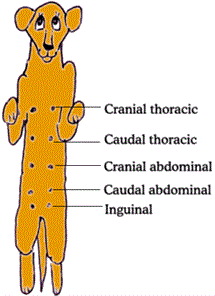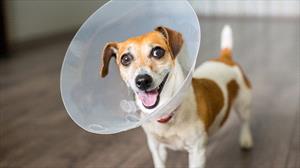Surgical sterilization of the female dog, commonly referred to as spaying, is one of the most significant aspects of care an owner can provide for their female dog. The benefits to the dog far outweigh simply not having puppies, though as pet overpopulation is a wide-spread societal problem, it is important to consider the bigger picture as well and be part of the solution rather than part of the problem.
Spaying involves the removal of the uterus and ovaries. It is a major surgery but a very commonly performed one, most safely performed while a female dog is still in puppyhood, prior to her first heat cycle.
All the Reasons you Should Spay your Female Dog
Mammary Cancer Prevention
A female dog spayed before her first heat will have a near-zero chance of developing mammary cancer.
Mammary cancer graphic

Graphic by MarVistaVet
After the first heat, the incidence of tumor development climbs to 7% and after the second heat, the risk is 25% (one in four!). It is easy to see that an early spay can completely prevent what is frequently a difficult and potentially fatal form of cancer.
But is it too late if a dog is already past her second heat? No, in fact, spaying is important even in female dogs who already have obvious tumors. This is because many mammary tumors are stimulated by estrogens; removing the ovaries, the source of estrogens will help retard tumor spread.
Spaying removes the uterus and both ovaries and is crucial in preventing as well as treating mammary cancer.
Pyometra Prevention
Pyometra is a life-threatening infection of the uterus that generally occurs in middle-aged to older female dogs in the six weeks following heat. The hormone progesterone, which primes the uterus for potential pregnancy, does so by causing the proliferation of the blood-filled uterine lining and suppressing uterine immune function. In heat, it is thus easy for bacteria in the vagina to ascend to the uterus to cause infection. The uterus with pyometra swells dramatically and is filled with pus, bacteria, dying tissue, and toxins. Without treatment, the dog is expected to die. Despite her serious medical state, emergency spay is the usual recommendation if her life is to be saved.

Illustration by Tamara Rees of VIN
- Pyometra is an very common and serious disease of unspayed female dogs. One in four unspayed female dogs who have survived to age 10 will get it.
- Without treatment, the dog will die.
- Treatment involves surgery on a potentially unstable patient. Mortality rates with surgery have been reported as high as 17%.
- Spaying prevents the whole thing.
Older, unspayed female dogs have an irregular heat cycle. There is no end of cycling comparable to human menopause. If you still decide against spaying, be familiar with the signs of pyometra, which include loss of appetite, lethargy, vomiting, excessive thirst, and usually (but not always) obvious vaginal discharge.
Simple Convenience
Female dogs come into heat every eight months or so. There is a bloody vaginal discharge and local male dogs are attracted. Often there is an offensive odor. All of this disappears with spaying, not to mention the inconvenience of an unplanned litter of puppies to house, clean, feed, and adopt out.
It’s Not Just a Good Idea; in Some Places, It’s the Law
For instance, the spaying of female dogs has been mandatory in the city of Los Angeles since 2008, which means it is not legal to own an unspayed female dog in that city. Exceptions include law enforcement dogs, dogs currently in competition training, service dogs, and dogs with a medical exemption. Fines begin at $100. The city came to this resolution largely because of the huge expenses associated with its overcrowded shelter system and its euthanasia rate of approximately 4,000 unwanted dogs and cats per month. This problem comes down to one of population control; education has been inadequate to solve the problem as has simply charging $100 vs $10 to license unsterilized dogs. Spaying provides irreplaceable health benefits to the pet, convenience to the pet owner, benefit to the community, and it is now legally required.
Check the laws in your area, or ask your veterinarian.
Now That We Know Why it is a Good Idea to Spay, What Exactly Happens?

The patient may have an intravenous catheter placed. Photo by MarVistaVet
It is important that the patient has not been fed for at least eight hours prior to surgery. Anesthetic medications commonly induce nausea and vomiting can be dangerous in a sedated patient (vomit can be inhaled/aspirated leading to pneumonia).
A preoperative evaluation is performed; blood work is recommended for older females and may be recommended as a normal pre-anesthetic consideration. An intravenous catheter may be placed to facilitate the administration of anesthetic drugs, for any fluid administration, and for use in case of emergency. This necessitates shaving a small patch of skin on one of the legs.
A tranquilizer or other pre-anesthetic medication may be administered to ease the induction of anesthesia.
A medication is given intravenously to induce sleep. This medication is called an induction agent and lasts only long enough to establish the maintenance of anesthesia by the inhalant anesthetic (gas). Once the dog is asleep, a tube is placed in her throat to ensure that a clear airway is maintained throughout the procedure.
Sometimes a cough is noted for a couple of days after surgery. This may have been caused by the tube in the throat. Such coughs only last a couple of days; anything that persists longer should be re-evaluated.
The tube is hooked up to a machine that delivers a specific concentration of inhalant gas mixed with 100% oxygen. A technician is assigned to monitor this pet so that the concentration of inhalant gas can be changed as needed and the patient's mucous membrane color, heart rate, respiration, and other parameters are followed.
In the surgical prep area, the abdomen is shaved and scrubbed. The bladder is emptied and the patient is moved to a surgical suite, where she is draped with surgical cloths or papers to isolate the area where the surgery will take place.
An incision is made on the midline of the abdomen, and the three points where the ovaries and uterus attach are tied off and cut. The abdomen is checked for bleeding and two or three layers of stitches are placed to close the incision.
It is helpful to know that should the skin stitches come out, there are two layers below holding everything closed. Sometimes skin stitches are not placed but if they are present, you will need to return in 10-14 days to have them removed. Sometimes the skin layer is omitted in which case returning will be unnecessary unless there is a problem.
The anesthesia technician continues monitoring until the dog wakes up and coughs out the throat tube.
The patient is kept in an observation room until she can walk.
Some veterinarians feel strongly that a night in the hospital is important to an uneventful recovery. This night in the hospital is similar to strict bed rest, just what you would expect to be needed after a major abdominal surgery. This night also allows for the proper administration of pain medication for a longer time as well as a post-operative check-up with the doctor the morning after surgery. As with all things medical, other veterinarians may have a different opinion and your veterinarian may send your dog home at the end of the day as long as they are deemed stable.
What to Expect at Home
Jack Russell in e-collar

The plastic cone is the traditional E-collar, but there are other types that may be more comfortable for your dog and your shins. Photo courtesy of Depositphotos.
Most spay surgery patients go home the same day or the next as if nothing had happened though pain medication will be provided to cover the next few days.
Some nausea may occur in the first couple of days after surgery and it would not be unusual for the pet to refuse food for a day after surgery.
As noted above, a cough may persist for a couple of days as a result of the throat tube. This should not persist for longer than a couple of days.
Dogs who show a propensity to lick their stitches will need an Elizabethan or "E" collar to restrict access to the stitches. This is not comfortable for the dog but it must be used strictly until the stitches are out and the incision is healed.
Activity should be restricted during the week following surgery. Excessive activity can lead to swelling or fluid accumulation under the incision or even worse, a tear in the internal incision line. If a fluid pocket forms, it should resolve on its own after a few weeks. If something has torn inside, obviously the situation is more serious so it is wise to have any incision swelling inspected at the veterinarian's office. Fluid drainage from the incision would also be a reason for a recheck.
What About Behavioral Changes?
The female dog's reproductive tract is dormant for most of the year. It only activates for the three-week period of heat. This means that from a behavioral standpoint, the female dog acts spayed most of the time. This said, there has been a documented slowing of metabolism after spays and it may be necessary to use a reduced-calorie food in an adult dog. Check with your veterinarian about nutritional recommendations.
What Age to Spay?
A lot of factors go into this question. As mentioned, dogs have a huge problem with mammary cancer development, and spaying before the first heat cycle (generally before the ages of six to eight months) removes this problem as a consideration. Spaying before the first heat is protective against an extremely common form of cancer and there is no question about it. Further, spaying while the dog is of a smaller size makes for less trouble with bleeding in surgery and an easier recovery after surgery. Larger dogs are a more difficult surgery and are generally more costly to spay. That said, research has shown that there is an increased incidence of some other problems in some breeds when they are spayed young.
For some breeds, there is an increased incidence of urinary incontinence associated with spaying before the age of one year.
For larger breeds, the situation becomes more complicated. The problem for large-breed female dogs is that some breeds have a higher incidence of joint and bone issues or increased incidence (albeit small increases) in other types of cancers when they are spayed young.
Issues regarding joint and bone problems, urinary incontinence, and cancers other than mammary cancer are highly dependent on breed such that findings for one breed do not hold true for another. To help clarify recommendations for different breeds, this research from UC Davis may be helpful: https://www.frontiersin.org/articles/10.3389/fvets.2020.00388/full. Field those questions to your regular veterinarian to find the best pathway for your own pet.